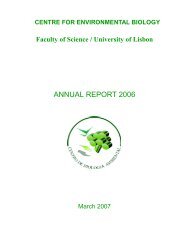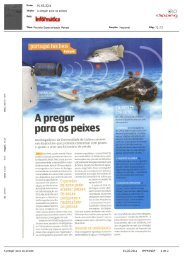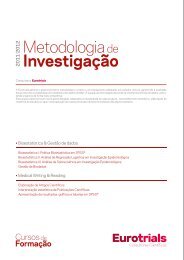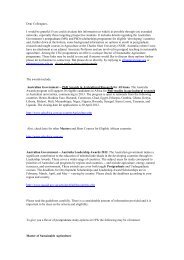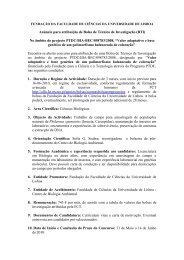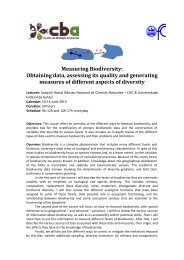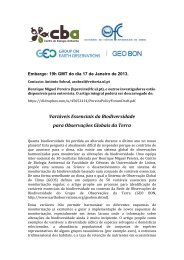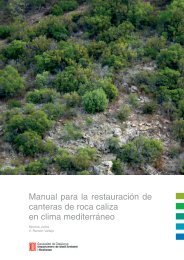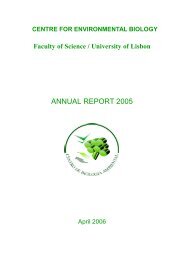European Red List of Vascular Plants - European Commission
European Red List of Vascular Plants - European Commission
European Red List of Vascular Plants - European Commission
You also want an ePaper? Increase the reach of your titles
YUMPU automatically turns print PDFs into web optimized ePapers that Google loves.
faced by any direct extinction risk) does not necessarily<br />
mean that it has a favourable conservation status’ (Anon.<br />
2007).<br />
Of the vascular plants assessed 467 species were<br />
assigned a threatened category and 436 have a declining<br />
population trend. Although intensified livestock farming,<br />
recreational activities, tourism and urban development,<br />
wild plant collection, invasive alien species, natural<br />
system modification and pollution have been identified<br />
as the main causes <strong>of</strong> decline in vascular plants within the<br />
three groups assessed, the results <strong>of</strong> this assessment are<br />
not representative <strong>of</strong> the overall threat status <strong>of</strong> vascular<br />
plants in Europe. Special emphasis needs to be placed on<br />
Data Deficient species, especially as some are known to<br />
be in a critical state <strong>of</strong> decline, but the lack <strong>of</strong> information<br />
from the entire range <strong>of</strong> these species meant that a threat<br />
category could not be assigned. These species could not<br />
be regarded as having Favourable Conservation Status.<br />
The species assessed as Least Concern should also not be<br />
ignored. If they are not already adequately conserved, both<br />
in situ and ex situ, the Least Concern assessment should<br />
be carefully interpreted as it does not necessarily mean<br />
that the species is not in need <strong>of</strong> conservation action – at<br />
minimum, population monitoring is likely to be needed.<br />
As emphasized various times in this publication, the <strong>Red</strong><br />
<strong>List</strong> assessment does not include genetic diversity within<br />
and between subpopulations – it is based on population<br />
size and range. As the goal <strong>of</strong> CWR conservation (and<br />
indeed vascular plant conservation in general) is to<br />
maximize the conservation <strong>of</strong> genetic diversity, it is vital<br />
that sufficient subpopulations are conserved, both in situ<br />
and ex situ, to provide the best possible sample <strong>of</strong> total<br />
genetic diversity (Maxted et al. 2008a,b). Knowledge <strong>of</strong><br />
the intrinsic pattern <strong>of</strong> genetic diversity is lacking for the<br />
majority <strong>of</strong> species as sampling and molecular analysis<br />
is resource intensive; therefore, it is necessary to ensure<br />
that as wide a range <strong>of</strong> ecogeographic diversity is sampled<br />
and conserved as possible – ecogeographic diversity<br />
being used as a proxy for genetic diversity (see Kell et al.<br />
2011b). This means that conservation <strong>of</strong> even the most<br />
widespread species is <strong>of</strong> concern, both at regional and<br />
national levels.<br />
6.7 <strong>Red</strong> <strong>List</strong> versus priority for<br />
conservation action<br />
Assessment <strong>of</strong> extinction risk and setting conservation<br />
priorities are two related but different processes.<br />
Assessment <strong>of</strong> extinction risk, such as the assignment <strong>of</strong><br />
IUCN <strong>Red</strong> <strong>List</strong> Categories, generally precedes the setting<br />
<strong>of</strong> conservation priorities. The purpose <strong>of</strong> the <strong>Red</strong> <strong>List</strong><br />
categorization is to produce a relative estimate <strong>of</strong> the<br />
likelihood <strong>of</strong> extinction <strong>of</strong> a taxon. Setting conservation<br />
priorities, on the other hand, normally includes the<br />
assessment <strong>of</strong> extinction risk, but also takes into<br />
account other factors such as ecological, phylogenetic,<br />
historical, economical, or cultural preferences for some<br />
taxa over others, as well as the probability <strong>of</strong> success <strong>of</strong><br />
conservation actions, availability <strong>of</strong> funds or personnel,<br />
cost-effectiveness, and legal frameworks for conservation<br />
<strong>of</strong> threatened taxa. In the context <strong>of</strong> regional risk<br />
assessments, a number <strong>of</strong> additional pieces <strong>of</strong> information<br />
are valuable for setting conservation priorities. For<br />
example, it is important to consider not only conditions<br />
within the region but also the status <strong>of</strong> the taxon from<br />
a global perspective and the proportion <strong>of</strong> the global<br />
population that occurs within the region. A decision on<br />
how these three variables, as well as other factors, are used<br />
for establishing conservation priorities is a matter for the<br />
regional authorities to determine.<br />
Trapa natans, Water Chestnut, is an aquatic plant that was consumed widely in Europe and still is in Asia. It is protected under the Bern Convention and is listed as Near Threatened in<br />
Europe. Photograph © Richard V. Lansdown.<br />
51



